In the second chapter of Việt Nam: A History from Earliest Times to the Present author Ben Kiernan has a passage where he writes about Việt society in the third century AD.
His point in this passage is to argue that even after a long period of Chinese rule, indigenous social and religious practices persisted.
To quote, he states that,
“Even after three hundred years and fifty years [sic] of imperial rule in Jiaozhi and Jiuzhen, and even as Confucianism took root among the emerging elite, the Chinese were still able to rule much of the countryside only indirectly, if at all. Việt customs and gender relations persisted.” (92)
What were some of these customs and gender relations? One, Kiernan argues, concerned the involvement of women in the performance of certain religious rites.
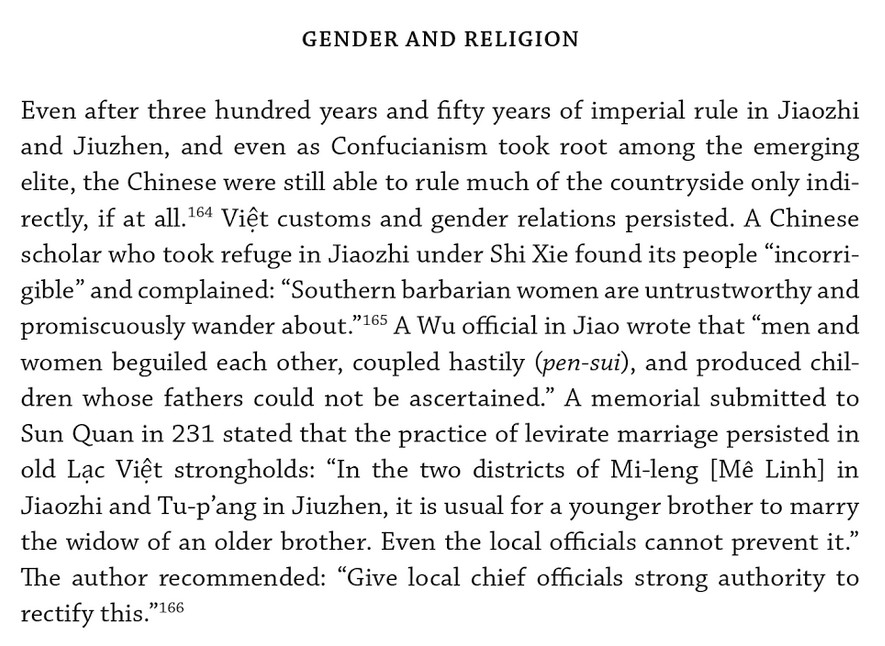
Earlier in the book Kiernan suggests that women had played an important role in the religious life of the Việt prior to the period when the Việt world was brought under the control of the Qin and Han dynasties starting at the end of the second century BCE.
He makes this claim by looking at the associations between certain words. To quote, he states that,
“The words for water (nác/nước) and ‘country’ (nước) derive from one of the archaic Vietnamese terms for woman (nàng), while another, nương, is also used to describe an upland field or swidden. Of two Vietnamese names for ‘witch, female medium,’ one (bóng) also means a type of drum. The other đồng, a homonym for both ‘bronze’ and ‘a field in the country,’ combines with an archaic term for ‘mother’ (áng) to form đồng áng (‘ricefields; the countryside’). All this suggests a possible Earth Mother cult and rituals associating water and fertility with bronze drums and female shamans.” (51-52)

Kiernan cites Huỳnh Sanh Thông’s self-published magnum opus, The Golden Serpent: How Humans Learned to Speak & Invent Culture, a book that I have written about here.
While the sounds of the above words as they appear in Vietnamese today may lead someone with little or no knowledge of the Vietnamese language to see connections and to believe Kiernan’s suggestion, the fact 1) that nàng/nương 娘 has existed in Chinese since at least the Tang Dynasty period and is likely to be the source of this term in Vietnamese, 2) that đồng 銅 is the Chinese word for bronze, 3) that the homonym đồng 童, literally meaning “child,” has been used in Chinese to refer to a “medium” for centuries, and as Maurice Durand explained decades ago in his Technique et pantheon des mediums viêtnamiens (ĐỒNG), is the origin of this term in Vietnamese, and 4) that there is no evidence that the words for water and country in Vietnamese derive from another word, let alone one that looks suspiciously like a medieval Chinese term, all indicate that this “word play” is simply that: word play.
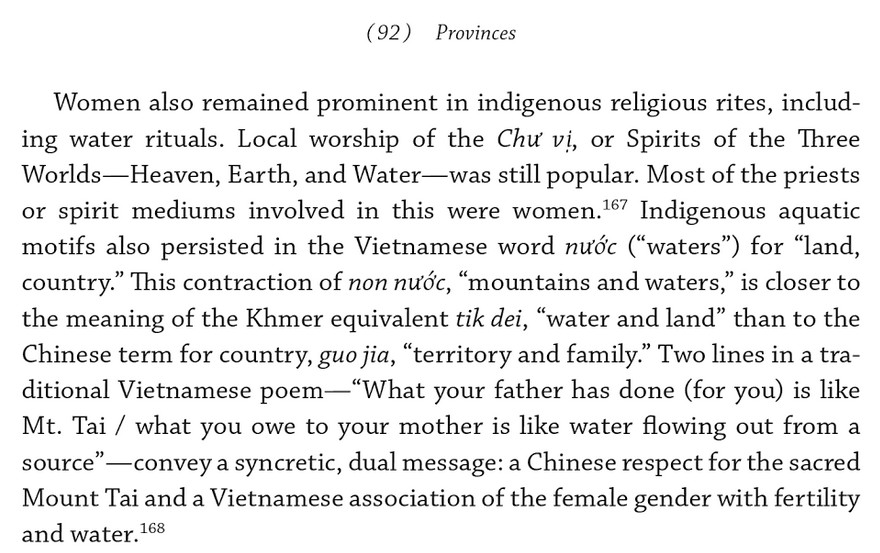
Nonetheless, this is enough for Kieran to then argue that “Even after three hundred years and fifty years of imperial [Chinese] rule,” that is, around the third century AD, that,
“Women also remained prominent in indigenous religious rites, including water rituals. Local worship of the Chư vị, or Spirits of the Three Worlds—Heaven, Earth, and Water—was still popular. Most of the spirit mediums involved in this were women.” (92)
I am familiar with the sources for this period of history, and I have never come across this information. Knowing that “Chư vị” comes from the Chinese, zhuwei 諸位, meaning something generic like the “various [honorable] ones,” I could obviously tell that whatever Kiernan was referring to here was not “indigenous.”
However, I had no idea where he got this information, so I checked his citation and it pointed to: Lê Thành Khôi, Histoire du Viêt Nam des origines à 1858 (Paris: Sudestasie, 1981), 98.

Although he was not trained as an historian, Lê Thành Khôi published the first survey of Vietnamese history in a Western language, his Le Viêt-Nam, Histoire et Civilisation (Paris: Editions de Minuit, 1955).
That work was of great assistance to Joseph Buttinger who not long after produced the first English-language survey of Vietnamese history, his The Smaller Dragon: A Political History of Vietnam (New York, Praeger, 1958).
Through his first book and its influence, Lê Thành Khôi played a very important role in increasing awareness about Vietnamese history in the West and even in helping to launch the field of Vietnamese history.
By the time that his Histoire du Viêt Nam des origines à 1858 came out in 1981, however, the field of Vietnamese history in the English-speaking world, small though it still was, had started to surpass Lê Thành Khôi.
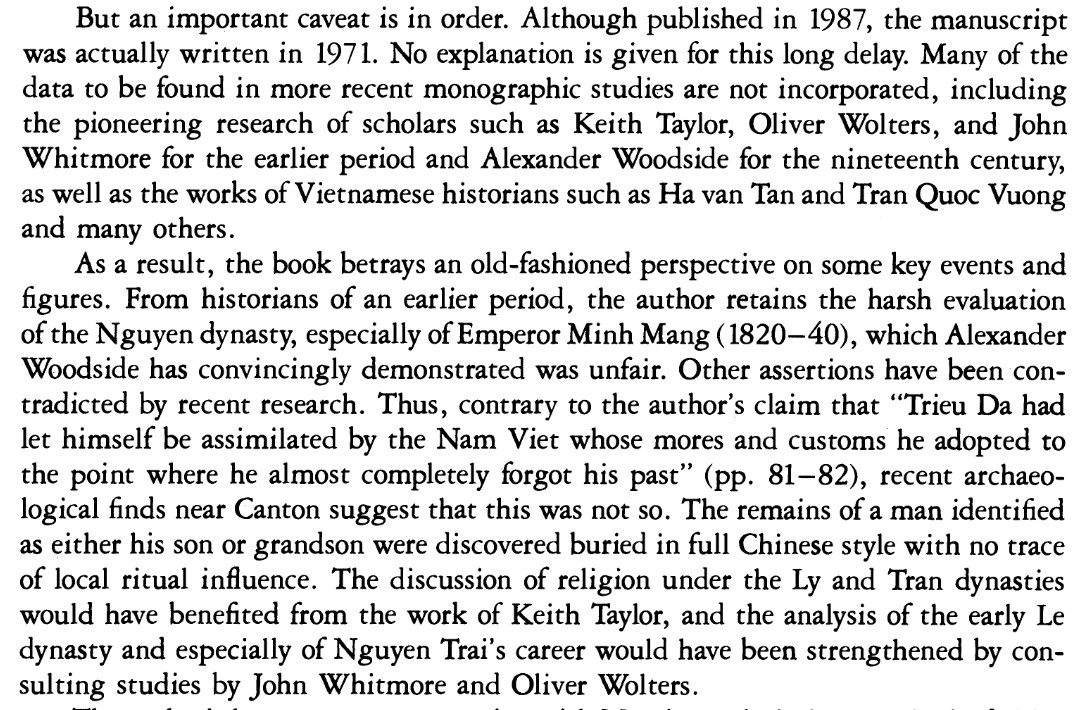
Part of the problem was that Lê Thành Khôi completed writing Histoire du Viêt Nam in 1971, but it was not published until a decade later in 1981. As such, as historian Pierre Brocheux pointed out in a 1983 review, it did not take into consideration such developments as the publication of a pioneering work on the Nguyễn Dynasty by Alexander Woodside.
Historian Hue-Tam Ho Tai made a similar point in a 1990 review of (apparently a 1987 edition of) the book, stating that,
“. . . the book betrays an old-fashioned perspective on some key events and figures. From historians of an earlier period, the author retains the harsh evaluation of the Nguyễn dynasty, especially of Emperor Minh Mang (1820-40), which Alexander Woodside has convincingly demonstrated was unfair.” (The Journal of Asian Studies, Vol. 49, No. 1 [1990], pp. 212-214)
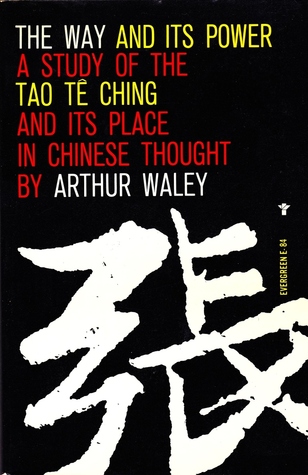
In looking for the passage from Histoire du Viêt Nam that Kiernan cited, I was reminded of the above assessments.
In examining a work of secondary scholarship, I always observe the sources that the author cites. In the case of Histoire du Viêt Nam, in the pages before the passage that Kiernan cited Lê Thành Khôi cites works like Arthur Waley’s 1934 The Way and its Power, A Study of the Tao Te Ching and its Place in Chinese Thought, Marcel Granet’s 1934 La Pensée Chinoise, Max Müller’s Sacred Books of the East (1879-1885), an 1892 translation by Abel Des Michels of the first volume of the Nguyễn Dynasty official history, the Khâm định Việt sử Thông giám cương mục [Imperially Commissioned Itemized Summaries of the Comprehensive Mirror of Việt History], and Camile Sainson’s 1896 translation of the thirteenth-century An Nam chi lược [Brief Record of An Nam].
From seeing sources like these I can immediately see that Lê Thành Khôi was working with what are now considered old ideas (Waley and Granet) and old translations (Müller, Des Michels, Sainson).
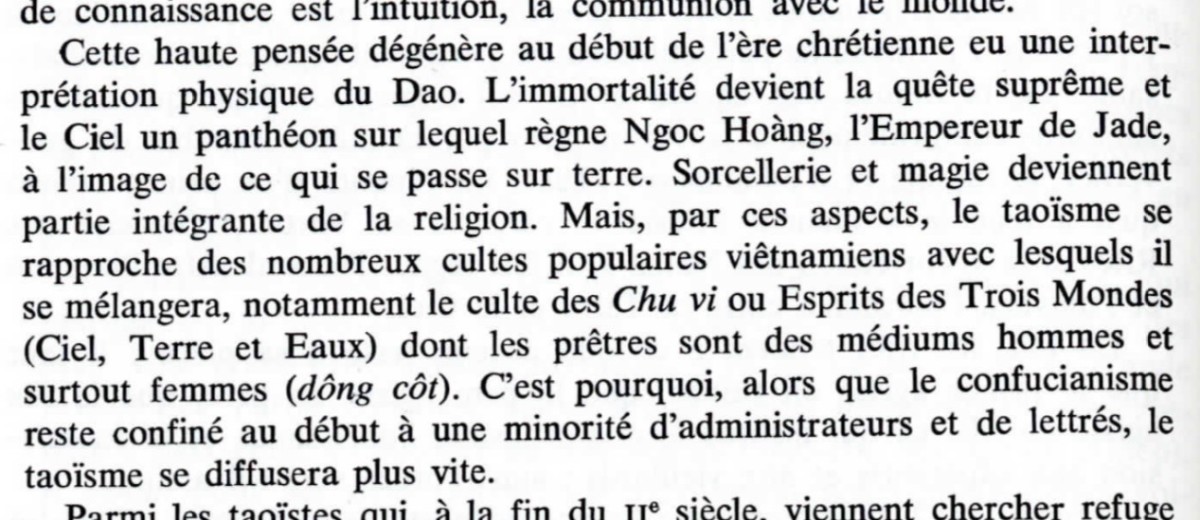
As for the actual passage that Kiernan cites, it appears in a section on “the diffusion of Confucianism and Daoism” in the early centuries CE. In writing about Daoism, Lê Thành Khôi talks about its basic philosophical principles and then states that from these “high ideas” it “degenerated” in the early centuries AD into a quest for immortality and the worship of a pantheon of deities under the Jade Emperor.
Here again, we see more signs of how dated this work now is. While the idea that Daoism began with a pristine philosophical tradition that then “degenerated” into religious forms of practice and worship is one that was common among Western scholars in 1971, it is now seen as an artificial distinction between practices that shared common philosophical ideas.
Histoire du Viêt Nam is thus a problematic text to work with. Rather than being a straight-forward resource that we can turn to for information about Vietnamese history, it is now more helpful as an example of how knowledge about Vietnamese history was constructed (for a largely non-Vietnamese audience) by an intelligent young overseas Vietnamese intellectual in the immediate post-colonial era.
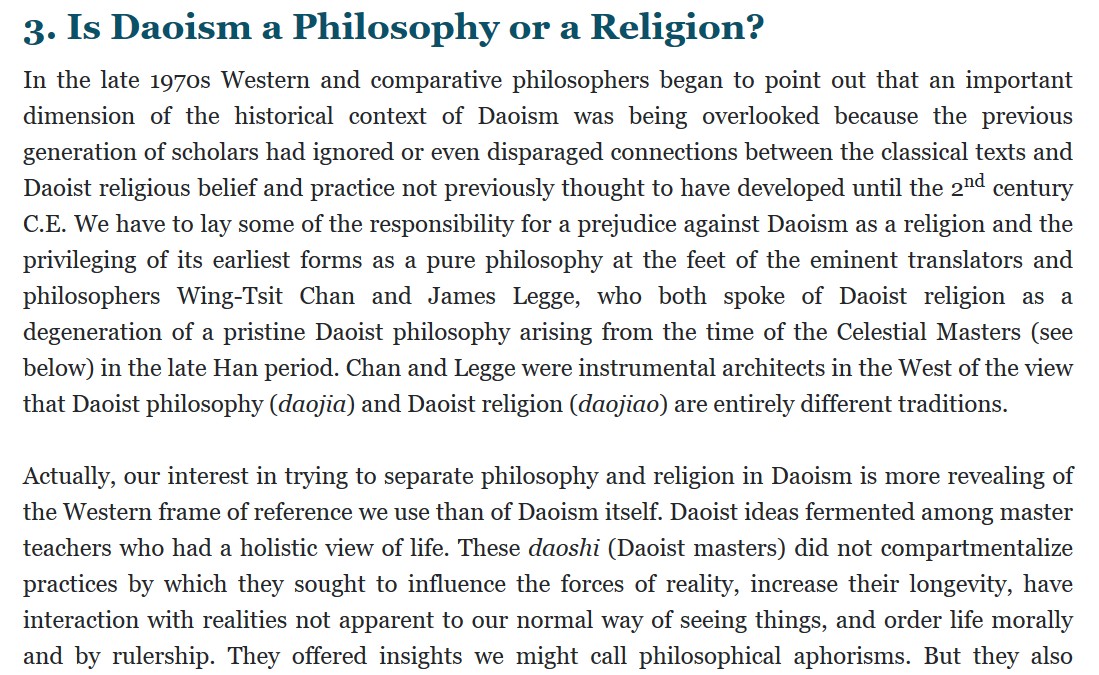
Let us now look at what Lê Thành Khôi supposedly wrote about female spirit mediums in the third century CE.
After noting that Daoism “degenerated” into such practices as a quest for immortality, sorcery and magic, he states that,
“But, in these aspects, Daoism was close to many popular Vietnamese cults that it would mix with, notably the cult of the Chư vị or the Spirits of the Three Worlds (Heaven, Earth and Water), the priests of which were male mediums and especially women (đồng cốt).
“That is why, while Confucianism was initially confined to a minority of administrators and letters, Daoism would spread more quickly.”
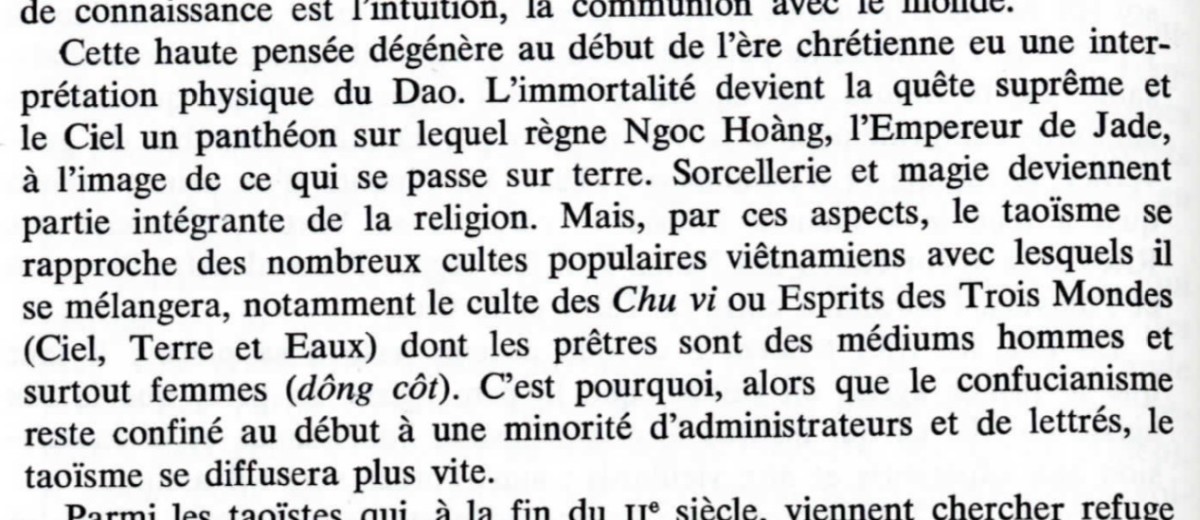
There are some points here that are worth noting. The first is that Lê Thành Khôi does not cite any source for this information.
Let me repeat that:
Lê Thành Khôi does not cite any source for this information.
That is an important point that a professional historian will easily recognize.
The second point is that Lê Thành Khôi’s ideas and language are vague here because he is following a French style in writing about the past by using the historical present (présent historique) and the historical future (futur historique) that in this context proves to be quite imprecise.
He uses the historical present tense to talk about the changes that Daoism underwent in the first centuries of the common era: the high ideas degenerated (dégénère; degenerate), sorcery and magic became (deviennent; become) part of the religion, etc.
He then uses the historical future tense to talk about how these new Daoist practices that emerged at that time would mix (se mélangera; will mix) with popular Vietnamese cults and how Daoism would spread (diffusera; will spread) faster than Confucianism.
Finally, he states that one of the cults that Daoist ideas would mix with is the Chư vị or the Spirits of the Three Worlds (Heaven, Earth and Water).
This leads the reader to some very fundamental questions:
When did these developments that Le Thành Khôi says would occur actually occur? He does not say.
What was the Chư vị or the Spirits of the Three Worlds like before it mixed with Daoist practices and ideas (whenever that was)? Lê Thành Khôi does not say.
How does he know that the Chư vị or the Spirits of the Three Worlds pre-existed the presence of Daoist practices in the region? Lê Thành Khôi does not say.
Again, Lê Thành Khôi does not cite any source for the information he presents here, and he presents this undocumented information imprecisely.
And again, these are important points that a professional historian will easily recognize.
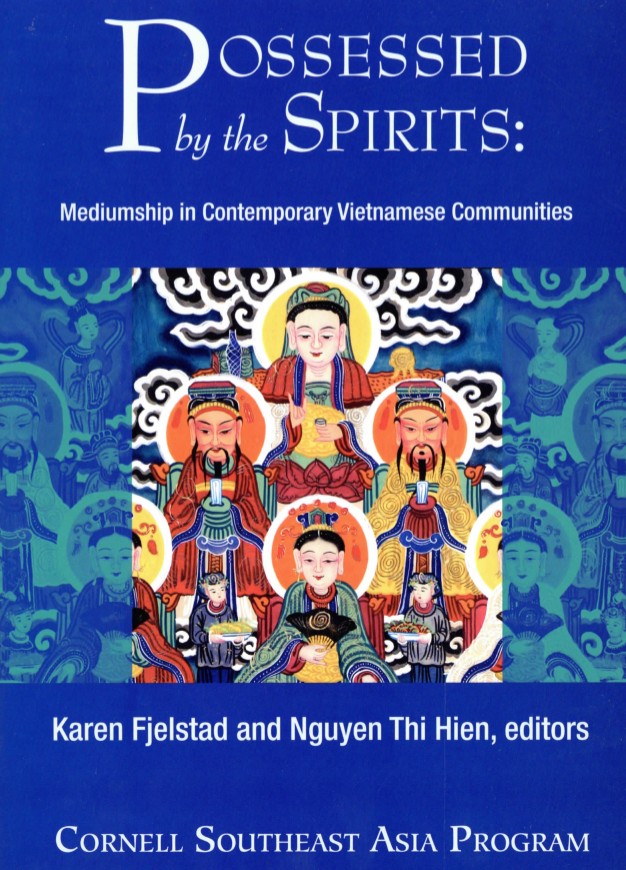
What exactly are the Chư vị or the Spirits of the Three Worlds? That is a reference to a cult that is now commonly referred to as the “Mother Goddess” (Thánh Mẫu 聖母) cult. There are many spirits in the pantheon of this cult, and these “various [honorable] ones” (Chư vị 諸位) are subsumed under different “palaces” (rather than “worlds”), that in turn are under the ultimate authority of the Jade Emperor. Sometimes three palaces are referred to (Tam Phủ 三府), corresponding to heaven, earth and water, and sometimes the forest or mountains make up a fourth palace (Tứ Phủ 四府).
All of these terms—Chư vị, Tam Phủ, Tứ Phủ–come from literary Chinese, as does the term for medium, đồng. The main deity in this tradition, the Jade Emperor, is of course central to Daoism. The written records that this cult produce at the turn of the twentieth century are filled with Confucian values. The list of “Sinitic” elements in this cult goes on and on and on.
So what is “indigenous” about the Chư vị? Or how can we determine if there was a cult that pre-existed a time of mixing with Daoist practices?
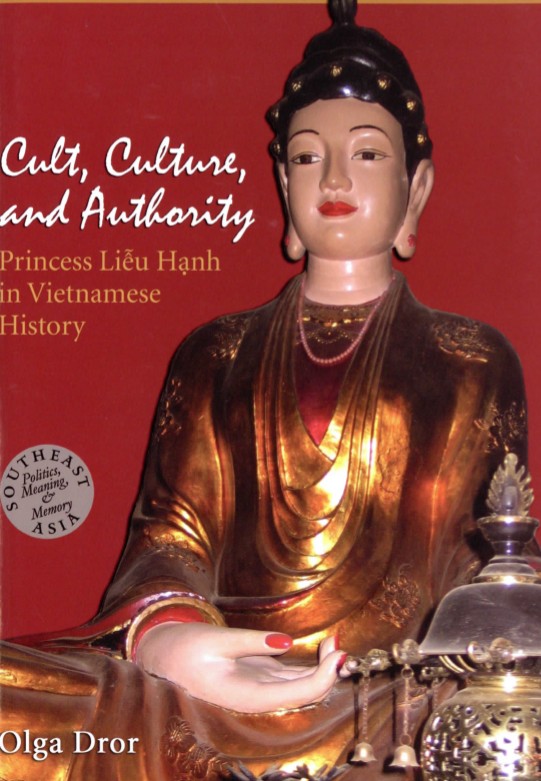
For that we need to turn to historian Olga Dror’s Cult, Culture, and Authority: Princess Liễu Hạnh in Vietnamese History (Honolulu: University of Hawaii Press, 2007). Dror discusses what we can know about the Mother Goddess cult based on the evidence that exists.
She does not talk about ancient female shamans because we do not have any evidence of that.
She does not say that in the third century AD “Women also remained prominent in indigenous religious rites, including water rituals” because we do not have any evidence of that.
Instead, it is only in the fifteenth and sixteenth centuries that Dror begins to identify possible evidence of the existence of a cult dedicated to Liễu Hạnh, the main deity in the Mother Goddess cult.
By that time the Vietnamese world had been in contact with East Asian religious practices for centuries. So is the Mother Goddess cult an indigenous cult that mixed with Daoism at that late time? We have no evidence of that.
All we have evidence of is the emergence of a religious cult in Vietnam in the late imperial period that, like cults devoted to female deities across the East Asian world at that time, involved spirit mediums, Daoist deities, the promotion of Confucian morality, etc.
This is the cult that Lê Thành Khôi undoubtedly observed growing up in Vietnam in the first half of the twentieth century. He knew that there was a lot about it that was Daoist, but he had no idea how it came into existence.
Professional historians today, like Olga Dror, likewise cannot say for certain how or when it came into existence, but they are sure that that there is no evidence that points to the third century AD, let alone even earlier.
Lê Thành Khôi did not provide evidence that could support such points either, nor has anyone else ever done so.
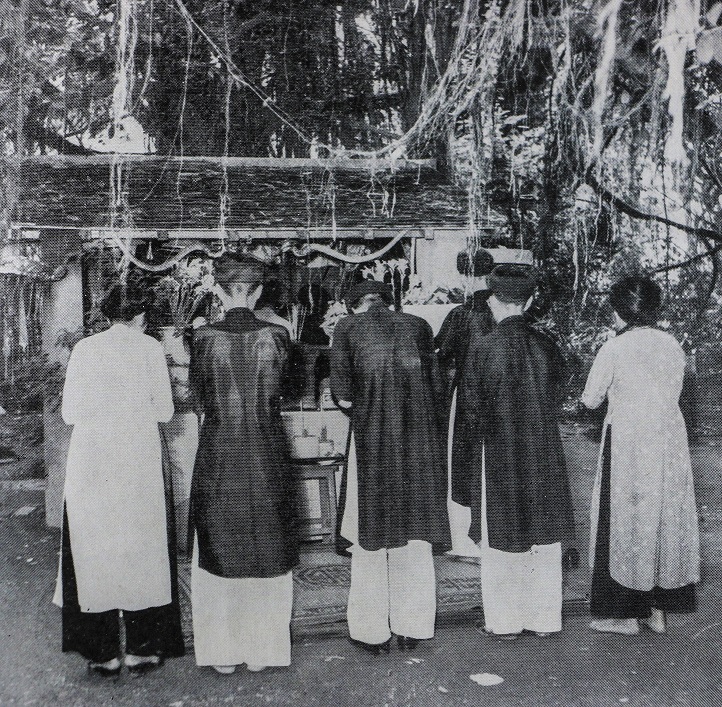
Lê Thành Khôi played a very important role in introducing Vietnamese history to a Western audience in the 1950s-1970s.
Today, however, it is difficult to make scholarly use of a work like Histoire du Viêt Nam. It contains sources and ideas that are outdated, and the style of presentation, as the above example indicates, can at times be problematic.
Of course if one knows how the field of Vietnamese history has developed over the past 50 years, and if one knows how ideas about Chinese history and culture have developed over that same time period, and if one also knows enough about Vietnamese society and culture to be able to see the contradictions in some of the vague wording that Lê Thành Khôi employed, then it is possible to read Histoire du Viêt Nam today and place it in perspective.
Even then though it is still much more helpful as an example of how knowledge about Vietnamese history was produced in a certain historical time and place and by a certain individual than it is as a resource for us today to learn about Vietnamese history.
It is fascinating to see how and what Lê Thành Khôi thought, however today there are other sources that are more up-to-date in recording what we do and can know about Vietnamese history. After all, 1971 was a long time ago. This should not surprise anyone.
And again, these are all important points that a professional historian will easily recognize.


This Post Has 2 Comments
Theo An Chi thì từ “nước” chỉ quốc gia và từ “nước” chỉ chất lỏng không phải là hai từ đồng nguyên. Từ “nước” chỉ quốc gia bắt nguồn từ từ tiếng Hán “略” ( http://petrotimes.vn/la-nuoc-la-cai-365586.html )
I think it is very easy to get into speculative trap with this kind of word origin deduction. China is a big country in the past. Words got into dictionary could be from local, not widespread and official. And coincidence of sounds could also play a role.